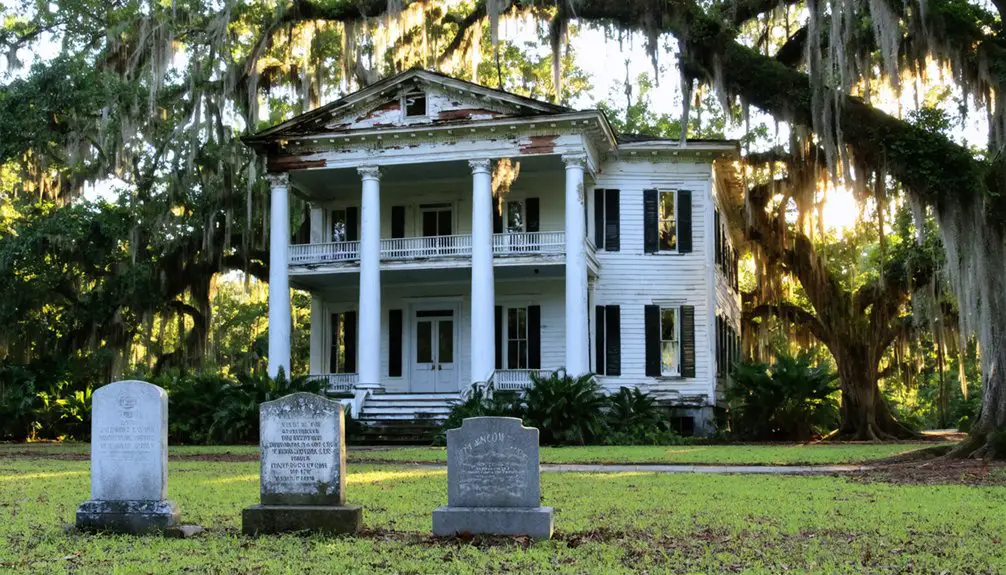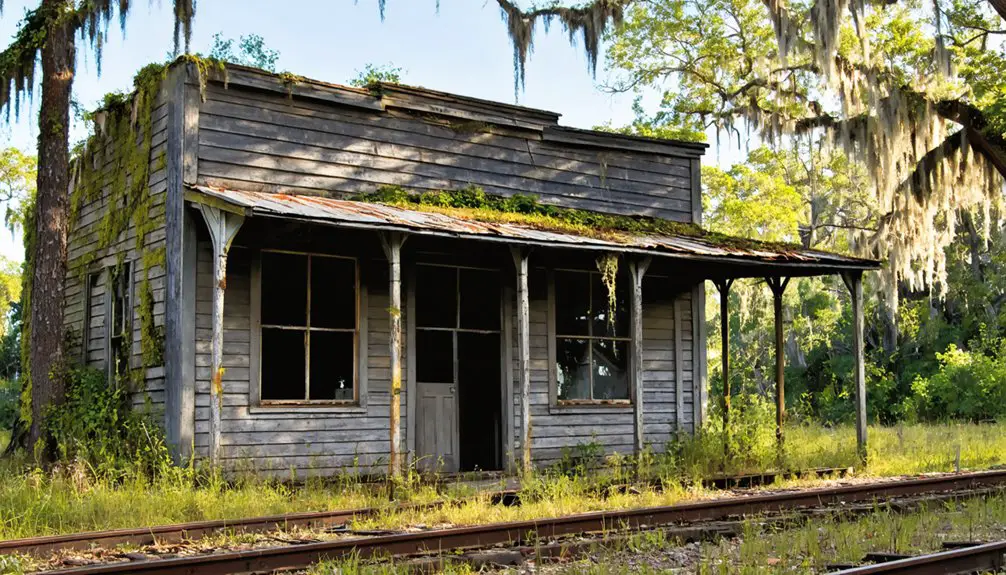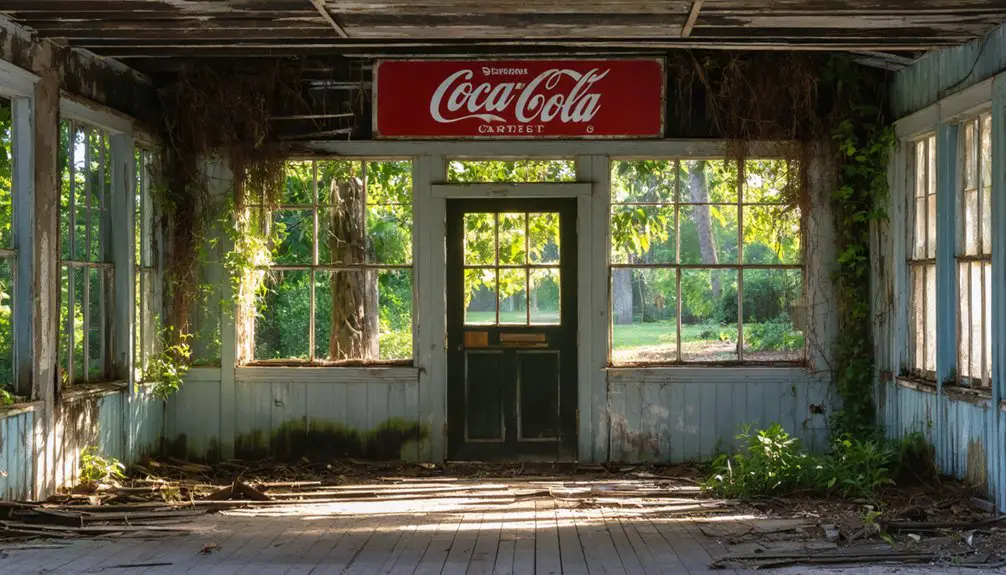You’ll find Neilson’s ghost town remains near Florida’s St. Johns River, where it once thrived as a prosperous citrus-growing community in the late 1800s. The settlement boasted a vibrant mix of Scots-Irish pioneers and British immigrants who established orange groves and cattle ranches. After the devastating Great Freeze of 1894-95 destroyed the citrus crops, residents abandoned their homes and livelihoods. Today, weathered cemetery stones and overgrown foundations tell a compelling story of frontier ambition and natural disaster that shaped Central Florida’s history.
Key Takeaways
- Neilson was a thriving agricultural settlement near the St. Johns River that relied primarily on citrus farming and cattle raising.
- The devastating Great Freeze of 1894-95 destroyed vital citrus crops, causing widespread abandonment of homes and businesses.
- Limited transportation infrastructure and economic collapse following the freeze led to the settlement’s eventual transformation into a ghost town.
- Physical remnants include a weathered cemetery, structural foundations, and deteriorating industrial elements near the Withlacoochee River.
- The town’s history is preserved through National Park records, archaeological surveys, and educational programs documenting its Scottish-Irish pioneer heritage.
The Rise of a Florida Frontier Settlement
Three key factors drove Neilson’s emergence as a Florida frontier settlement in the late 19th century: its strategic location, diverse immigrant population, and robust transportation links.
You’ll find Neilson’s settlement patterns were shaped by its position near the St. Johns River and the historic Cowford crossing, where the King’s Road connected essential colonial routes across East Florida.
The town’s cultural influences reflected a rich tapestry of Scots-Irish pioneers from the Carolinas, British immigrants, and settlers from Caribbean colonies. Like many frontier communities, the residents engaged in cattle raising as their primary source of income.
As you explore Neilson’s history, you’ll discover how the Sugar Belt Railroad and steamboat routes transformed this frontier outpost into a thriving community.
These transportation arteries didn’t just move goods – they brought waves of English agricultural workers and tradesmen who shaped the town’s diverse frontier character.
The settlement’s early success was aided by the fresh water sinkholes that provided reliable water sources in the limestone-rich terrain.
Daily Life in 19th Century Neilson
If you’d visited Neilson in the late 1800s, you’d have found residents tending to their citrus groves and small vegetable gardens, while others hunted game or fished in nearby waters to supplement their food supplies.
You’d have traveled these frontier lands by foot, horseback, or wagon along dirt paths, with ferry crossings serving as essential links to neighboring settlements like Welaka.
The community’s social fabric centered around shared work activities, religious gatherings, and celebrations, helping residents maintain close bonds despite their relative isolation. Like many frontier towns of that era, the absence of law enforcement officers often meant communities had to maintain order through informal means. The brutal winter freezes of 1894-1899 devastated local citrus crops, leading many families to abandon their homes and livelihoods.
Farming and Food Production
Life in nineteenth-century Neilson revolved around small-scale farming and food production, with early settlers like John and Lydia Neilson establishing agricultural homesteads as early as 1777.
You’d find families practicing sustainable practices through mixed farming, growing staple crops suited to Florida’s climate while maintaining livestock. Orange groves flourished until devastating freezes in the 1890s changed everything. Like many communities documented in Florida’s past, the Great Depression severely impacted local farming operations.
You’d see oxen teams plowing fields and hauling crops, while windmills dotted the landscape. Like the settlers in Alto, they cultivated peanuts and corn to sustain their families. Families relied on fresh seasonal produce and basic food preservation methods, supplementing their diets through hunting and fishing.
Through crop rotation and trading surplus goods with neighboring communities, settlers maintained relative self-sufficiency. When crop failures and freezes struck, many farmers adapted by shifting to ranching, though some ultimately abandoned their homesteads for opportunities elsewhere.
Local Transportation Methods
Transportation in nineteenth-century Neilson centered on horse-drawn conveyances and foot travel across a network of dirt roads and rough trails.
You’d find locals relying heavily on horseback transport for personal travel, while wagon logistics handled the movement of farm goods and supplies. Similar to the transport methods used by Civil War deserters seeking refuge in remote areas, riverboat travel along the St. Johns River provided essential connections to broader markets, though seasonal travel proved challenging due to unpredictable weather and poor road conditions.
Like those who ventured to dark sky locations for stargazing, community mobility depended entirely on animal power, with your daily errands typically accomplished on foot or horseback.
When you needed to transport heavier loads, horse-drawn wagons tackled the rough terrain, though transportation challenges intensified during wet seasons.
The nearby railroad stations in Buena Vista and Penial eventually expanded your travel options, connecting Neilson’s residents to the wider region despite the frontier setting.
Community Social Activities
While Neilson’s social fabric centered on its post office hub, daily life in this 19th-century community wove together through various gathering spaces and activities.
You’d find residents exchanging news and stories on their front porches, while church bells called neighbors to services and social events. Community gatherings often blended work with pleasure, as families supported each other through shared labor and celebration. Just as in Richwoods, a 3:00 PM bell would ring daily to mark time and bring the community together. Similar to Jerome, Arizona, which thrived with 15,000 residents during its peak, Neilson fostered a vibrant social atmosphere where neighbors knew one another intimately.
- The post office served as the heart of daily social interactions, where you’d catch up on local news while collecting mail.
- Church activities structured the social calendar with services, festivals, and seasonal celebrations bringing everyone together.
- Front porches became essential meeting spots where you’d join neighbors for storytelling, music, and informal visits.
Agricultural Legacy and Citrus Industry
Neilson’s citrus farmers originally used simple cultivation methods, relying on native soil conditions and manual labor to establish their groves.
You’ll find that the devastating freezes of 1894-1895 destroyed most of the area’s citrus crops, forcing many farmers to abandon their land when they couldn’t afford to replant.
Without its agricultural backbone, Neilson’s economy collapsed, leading to the town’s eventual abandonment as residents sought opportunities elsewhere.
Early Citrus Growing Methods
As Florida’s citrus industry took root in the early 1800s, growers developed distinctive cultivation methods suited to the region’s subtropical climate and sandy soils.
Early citrus propagation techniques relied heavily on grafting wild seedlings onto sweet orange varieties, while early irrigation methods called for about an inch of water weekly to maintain healthy production.
- You’d find groves strategically planted in well-drained soils, where citrus roots could thrive in Florida’s unique growing conditions.
- You could spot skilled growers monitoring their trees for aphids and other pests, a practice that became standard by the 1920s.
- Your success in growing citrus depended on proper fertilization, with nitrogen applications becoming widespread in the late 1920s, boosting both tree vigor and fruit yields.
Freeze Impact on Crops
When the devastating Great Freeze of 1894-95 swept through Florida, it transformed the state’s citrus industry forever.
You’ll find that northern growers, including those in Neilson, faced catastrophic losses as their fruit-bearing trees succumbed to the brutal cold. This event forced a dramatic shift in citrus production southward, as farmers sought warmer regions to rebuild their operations.
The freeze’s impact went beyond just crop damage – it reshaped the entire industry’s approach to citrus adaptation and freeze resilience.
Growers developed new protective measures, planted hardier varieties, and strengthened cooperative networks to manage future risks. This agricultural evolution meant some northern communities couldn’t recover, while central and southern Florida emerged as the new strongholds of citrus production, forever changing the state’s agricultural landscape.
Post-Agriculture Economic Collapse
The devastating collapse of Neilson’s citrus-based economy marked a turning point that would seal the town’s fate. As the agricultural innovation that once drove prosperity gave way to mounting challenges, you’d have witnessed the rapid unraveling of this once-thriving community.
The decline triggered economic migration as families sought opportunities elsewhere, leaving behind empty packinghouses and abandoned groves.
The collapse manifested in three distinct ways:
- Secondary businesses dependent on citrus operations shut down
- Tax revenue plummeted, degrading public services and infrastructure
- Property values fell as the workforce disappeared
What you’re seeing in Neilson today reflects the broader pattern of Florida’s ghost towns, where single-industry economies couldn’t survive the perfect storm of rising costs, disease outbreaks, and market shifts that devastated local citrus production.
Natural Disasters and Economic Downfall
During the late 19th century, devastating freezes struck Nelson, Florida, triggering a catastrophic chain of events that would ultimately lead to the town’s abandonment.
You’ll find that between 1894-1899, temperatures plummeted to as low as 6 degrees Fahrenheit, destroying the region’s essential citrus crops. These climatic impacts devastated local agriculture, particularly in nearby Putnam County.
The agricultural decline proved insurmountable as repeated freezes obliterated record crops, forcing residents to abandon their homes and livelihoods.
Without their primary source of income from orange groves, farmers couldn’t sustain their operations. Local businesses shuttered, and the population dwindled as people sought opportunities elsewhere.
The town’s isolation and limited transportation infrastructure only hastened its demise, making economic recovery virtually impossible.
Notable Families and Community Leaders

Several pioneering families shaped Neilson’s early development through their homesteading efforts and community leadership. Prominent families like Randall and Ned Wilson established strong foundations by sharing resources and working cooperatively to maintain their land claims under the Homestead Act of 1862.
Community leaders, particularly those documented by the Fruitland Peninsula Historical Society, played vital roles in developing the area’s infrastructure and preserving its history.
- The Randall and Wilson families exemplified early settler resilience by sharing living quarters and supporting each other’s land claims.
- African-American families built lasting communities centered around institutions like the Oak Groves Missionary Baptist Church.
- The Buo family’s Boville Plantation greatly influenced local commerce until its destruction during the 1836 Seminole Wars.
You’ll find these families’ legacies preserved through National Park records and local historical collections.
Remnants and Historical Landmarks Today
Modern visitors to Neilson will find three primary types of remnants scattered throughout this forgotten Florida settlement: a weathered cemetery with aged headstones, overgrown structural foundations hidden in dense forest, and deteriorating industrial elements from its railway past.
For those interested in ghost town exploration, you’ll discover limited historical markers near the cemetery and road junctions marking this once-thriving community.
The Withlacoochee River and surrounding woodlands now embrace what’s left of Neilson’s infrastructure. You can still trace old trails and gravel roads that once served the town, though nature has reclaimed most areas.
While historical preservation efforts remain minimal, nearby communities have incorporated Neilson’s story into regional heritage trails, keeping its memory alive through photographs and oral histories.
Preserving Neilson’s Place in Florida History

The preservation of Neilson’s historical legacy remains an active endeavor through coordinated efforts of local historical societies and preservation groups in Putnam County.
Local historians and preservationists work tirelessly to protect and document Neilson’s heritage for future generations in Putnam County.
Despite preservation challenges, ongoing archival efforts include documenting artifacts, mapping historic sites, and maintaining cemetery records that tell the story of this once-thriving community.
You’ll find dedicated volunteers and historians working to keep Neilson’s memory alive through:
- Educational programs and guided tours that highlight the town’s role in Florida’s development
- Archaeological surveys using ground-penetrating radar to map remaining structures without disturbing the sites
- Digital preservation initiatives that capture and store historical records, photographs, and personal accounts
Local preservation policies help protect these essential historical resources while making them accessible for research and education, ensuring future generations can understand Neilson’s significance in Florida’s past.
Frequently Asked Questions
Was Neilson Ever Connected to Florida’s Railroad System?
You won’t find direct evidence of railroad connections at Neilson in transportation history records, though it likely relied on nearby rail lines serving other Pasco County communities.
What Native American Tribes Originally Inhabited the Neilson Area?
Like ancient footprints in time, the Alachua Seminoles dominated this area’s tribal history, though they weren’t the first – earlier indigenous peoples left their cultural significance through shell middens and village sites.
Were There Any Schools or Churches Established in Neilson?
You won’t find verified records of schools or churches in this settlement. While similar ghost towns had basic institutions, the town’s school history and church significance remain undocumented in historical archives.
Did Any Famous Historical Figures Ever Visit or Stay in Neilson?
You won’t find any documented evidence of famous visitors or historical figures staying in Neilson. The town’s historical significance remained local, without attracting prominent personalities during its brief existence.
What Happened to the Property Deeds After the Town Was Abandoned?
Paper trails never lie. You’ll find the property ownership records stayed with county clerk offices, maintaining legal deed transfer capabilities even after abandonment – just like they do for all Florida ghost towns.
References
- https://www.onlyinyourstate.com/experiences/nevada/nearly-abandoned-mining-town-nefarious-past-nv
- https://www.youtube.com/watch?v=MlH4SKnmgao
- https://www.palatkadailynews.com/local-around-putnam/exploring-putnam-countys-past-look-local-ghost-towns
- https://www.tripadvisor.com/Attraction_Review-g1093759-d4446411-Reviews-Nelson_Ghost_Town-Nelson_Nevada.html
- https://en.wikipedia.org/wiki/List_of_ghost_towns_in_Florida
- https://files.floridados.gov/media/694158/smallflorida_british_heritage_trail_pdf.pdf
- https://en.wikipedia.org/wiki/History_of_Florida
- https://stars.library.ucf.edu/cgi/viewcontent.cgi?article=4159&context=fhq
- https://www.youtube.com/watch?v=Y4_GAiTzhYM
- https://bittersoutherner.com/the-first-floridians-fort-mose-st-augustine



